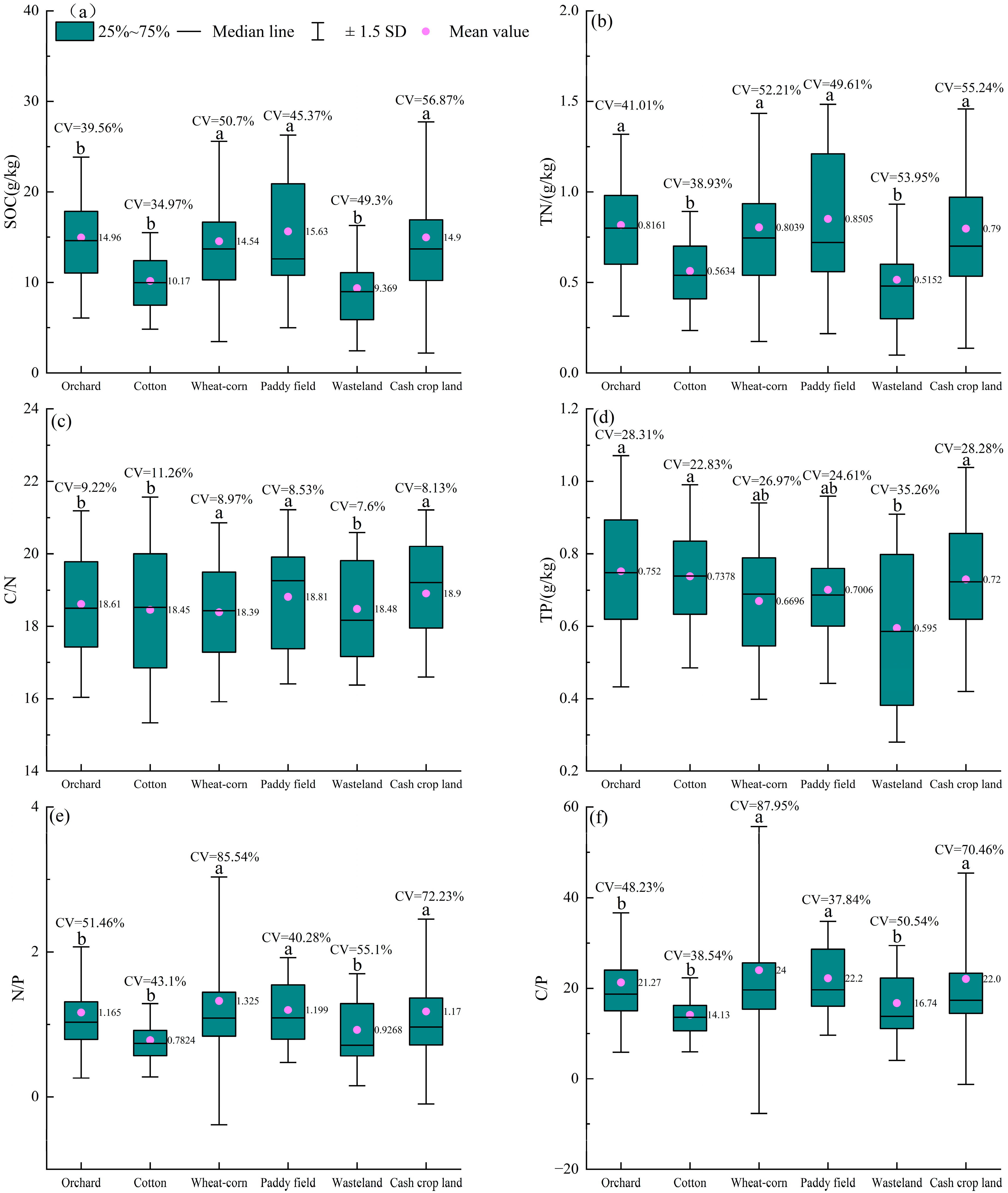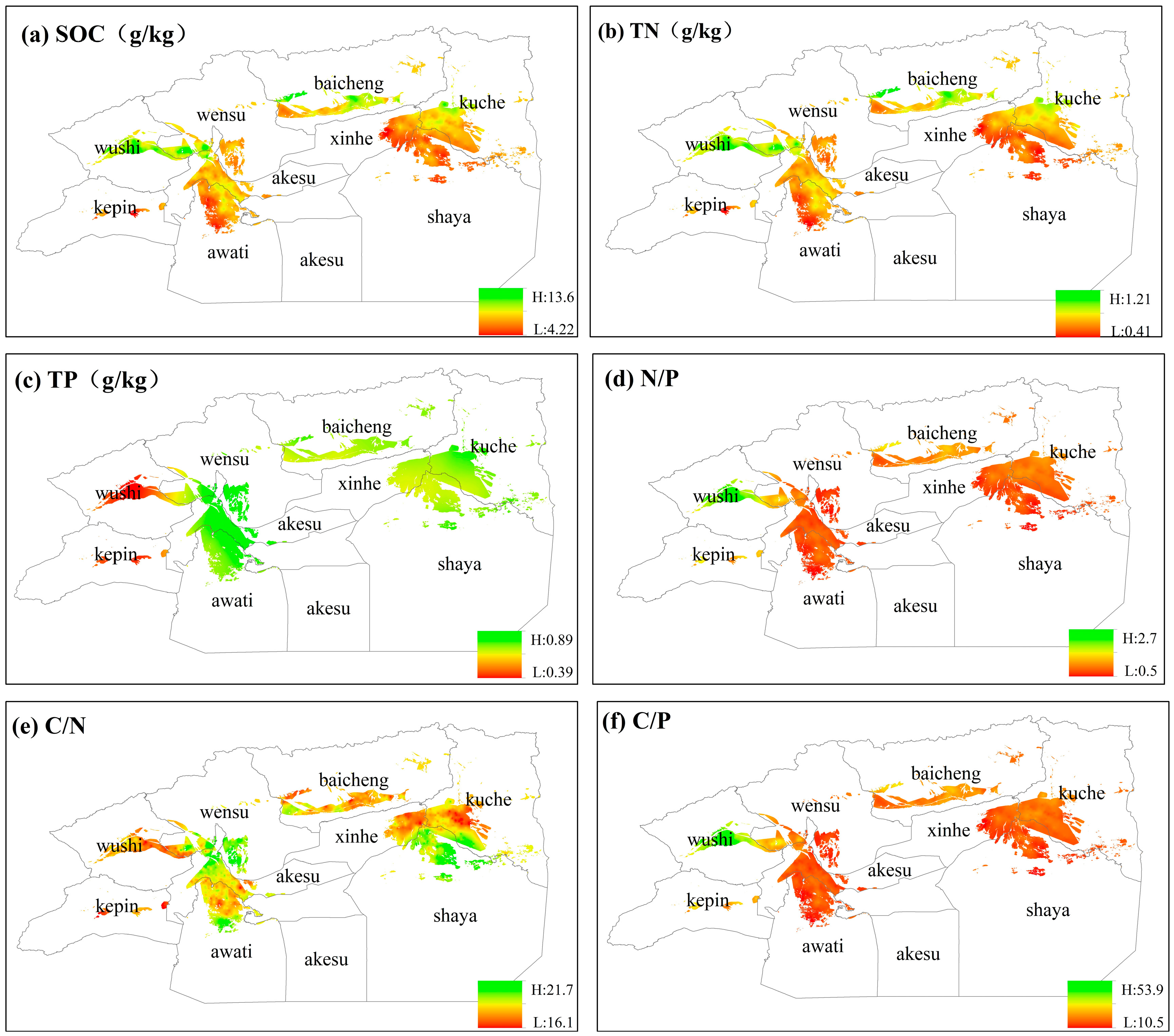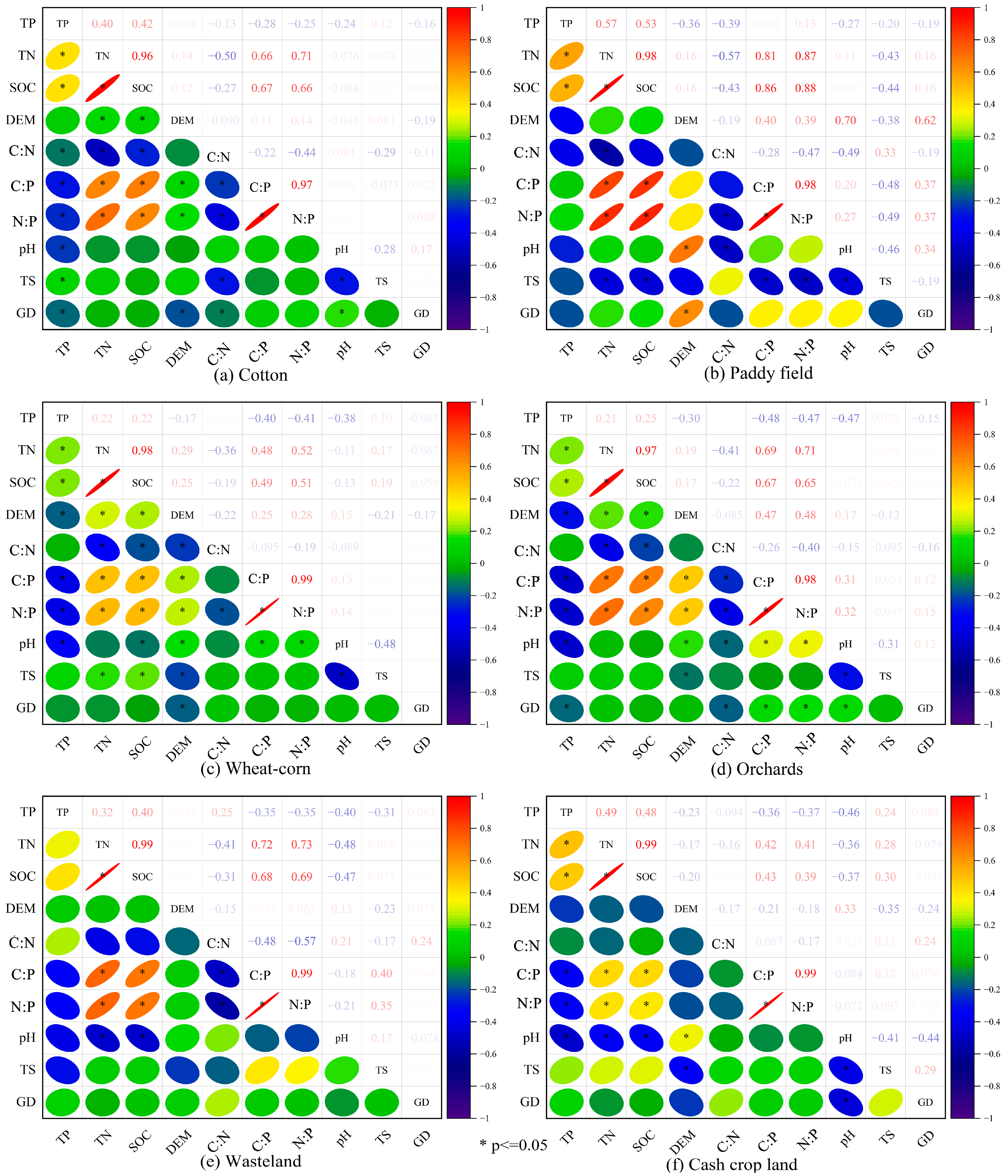Analysis of Soil Nutrient Content and Carbon Pool Dynamics Under Different Cropping Systems
Abstract
1. Introduction
2. Materials and Methods
2.1. Overview of the Study Area
2.2. Study Methods
2.2.1. Sample Collection
2.2.2. Semi-Variable Function Models
2.2.3. Model for Estimating Soil C, N and P Stocks
2.2.4. Data Processing
3. Results
3.1. Statistical Characteristics of Soil Nutrient Content and C:N:P Ratios
3.2. Spatial Autocorrelation of Soil Nutrient Content and C:N:P Ratio
3.3. Spatial Distribution Patterns of Soil Nutrient Contents and C:N:P Ratios
3.4. Analysis of Factors Influencing Soil SOC, TN, TP, and C:N:P Ratios Across Cropping Systems
3.5. Analysis of Environmental Drivers and Interrelationships of Soil Carbon, Nitrogen, and Phosphorus Stocks, and Stoichiometric Ratios in Different Agricultural Systems
3.6. Analysis of Surface Soil Carbon, Nitrogen, and Phosphorus Stocks and Their Correlations
4. Discussion
4.1. Impacts of Cropping Systems on Soil SOC, TN, TP Contents, and C:N:P Ratios
4.2. Factors Influencing SOC, TN, TP, and C:N:P Ratios in the Aksu Farmland
4.3. Implications of Soil C:N:P Stoichiometry for Nutrient Management
5. Conclusions
Author Contributions
Funding
Institutional Review Board Statement
Informed Consent Statement
Data Availability Statement
Acknowledgments
Conflicts of Interest
References
- George, T.S.; Giles, C.D.; Menezes-Blackburn, D.; Condron, L.M.; Gama-Rodrigues, A.C.; Jaisi, D.; Lang, F.; Neal, A.L.; Stutter, M.I.; Almeida, D.S. Organic phosphorus in the terrestrial environment: A perspective on the state of the art and future priorities. Plant Soil 2018, 427, 191–208. [Google Scholar] [CrossRef]
- Abbas, F.; Hammad, H.M.; Ishaq, W.; Farooque, A.A.; Bakhat, H.F.; Zia, Z.; Fahad, S.; Farhad, W.; Cerdà, A. A review of soil carbon dynamics resulting from agricultural practices. J. Environ. Manag. 2020, 268, 110319. [Google Scholar] [CrossRef]
- Sanaullah, M.; Usman, M.; Wakeel, A.; Cheema, S.A.; Ashraf, I.; Farooq, M. Terrestrial ecosystem functioning affected by agricultural management systems: A review. Soil Tillage Res. 2020, 196, 104464. [Google Scholar] [CrossRef]
- Feng, W.-L.; Yang, J.-L.; Xu, L.-G.; Zhang, G.-L. The spatial variations and driving factors of C, N, P stoichiometric characteristics of plant and soil in the terrestrial ecosystem. Sci. Total Environ. 2024, 175543. [Google Scholar] [CrossRef] [PubMed]
- Dawson, J.C.; Huggins, D.R.; Jones, S.S. Characterizing nitrogen use efficiency in natural and agricultural ecosystems to improve the performance of cereal crops in low-input and organic agricultural systems. Field Crops Res. 2008, 107, 89–101. [Google Scholar] [CrossRef]
- Tomaz, A.; Martins, I.; Catarino, A.; Mourinha, C.; Dôres, J.; Fabião, M.; Boteta, L.; Coutinho, J.; Patanita, M.; Palma, P. Insights into the spatial and temporal variability of soil attributes in irrigated farm fields and correlations with management practices: A multivariate statistical approach. Water 2022, 14, 3216. [Google Scholar] [CrossRef]
- Zheng, S.; Xia, Y.; Hu, Y.; Chen, X.; Rui, Y.; Gunina, A.; He, X.; Ge, T.; Wu, J.; Su, Y. Stoichiometry of carbon, nitrogen, and phosphorus in soil: Effects of agricultural land use and climate at a continental scale. Soil Tillage Res. 2021, 209, 104903. [Google Scholar] [CrossRef]
- Shen, H.; Huang, Y.; Lin, X.; Dai, Z.; Zhao, H.; Su, W.-Q.; Dahlgren, R.A.; Xu, J. Recoupling of Soil Carbon, Nitrogen, and Phosphorus Cycles along a 30 Year Fire Chronosequence in Boreal Forests of China. Environ. Sci. Technol. 2025, 59, 4432–4443. [Google Scholar] [CrossRef]
- Luo, H.; Li, J.; Li, P.; Rioual, P.; Zou, Y.; Zhang, J.; Yan, Y.; Li, J.; Wang, L. Variation in the seasonal response to climate change during the past 1000 years as inferred from a Maar Lake sediment record, northeast China. J. Paleolimnol. 2022, 68, 133–154. [Google Scholar] [CrossRef]
- Shen, F.; Wu, J.; Fan, H.; Liu, W.; Guo, X.; Duan, H.; Hu, L.; Lei, X.; Wei, X. Soil N/P and C/P ratio regulate the responses of soil microbial community composition and enzyme activities in a long-term nitrogen loaded Chinese fir forest. Plant Soil 2019, 436, 91–107. [Google Scholar] [CrossRef]
- Zhao, X.; Tian, Q.; Huang, L.; Lin, Q.; Wu, J.; Liu, F. Fine-root functional trait response to nitrogen deposition across forest ecosystems: A meta-analysis. Sci. Total Environ. 2022, 844, 157111. [Google Scholar] [CrossRef] [PubMed]
- Sardans, J.; Rivas-Ubach, A.; Penuelas, J. The elemental stoichiometry of aquatic and terrestrial ecosystems and its relationships with organismic lifestyle and ecosystem structure and function: A review and perspectives. Biogeochemistry 2012, 111, 1–39. [Google Scholar] [CrossRef]
- Yuan, Z.; Chen, H.Y. Decoupling of nitrogen and phosphorus in terrestrial plants associated with global changes. Nat. Clim. Change 2015, 5, 465–469. [Google Scholar] [CrossRef]
- Sokol, N.W.; Slessarev, E.; Marschmann, G.L.; Nicolas, A.; Blazewicz, S.J.; Brodie, E.L.; Firestone, M.K.; Foley, M.M.; Hestrin, R.; Hungate, B.A. Life and death in the soil microbiome: How ecological processes influence biogeochemistry. Nat. Rev. Microbiol. 2022, 20, 415–430. [Google Scholar] [CrossRef] [PubMed]
- Schönhart, M.; Schmid, E.; Schneider, U.A. CropRota–A crop rotation model to support integrated land use assessments. Eur. J. Agron. 2011, 34, 263–277. [Google Scholar] [CrossRef]
- Tian, S.; Xu, Y.; Wang, Q.; Zhang, Y.; Yuan, X.; Ma, Q.; Feng, X.; Ma, H.; Liu, J.; Liu, C. The effect of optimizing chemical fertilizers consumption structure to promote environmental protection, crop yield and reduce greenhouse gases emission in China. Sci. Total Environ. 2023, 857, 159349. [Google Scholar] [CrossRef]
- Yuan, S.; Li, R.; Zhang, Y.; Tang, J.; Wang, L.; Ji, H.; Huang, S. Effects of long-term partial substitution of inorganic fertilizer with pig manure and/or straw on nitrogen fractions and microbiological properties in greenhouse vegetable soils. J. Integr. Agric. 2024, 23, 2083–2098. [Google Scholar] [CrossRef]
- Zhang, L.; Feng, Y.; Zhao, Z.; Cui, Z.; Baoyin, B.; Wang, H.; Li, Q.; Cui, J. Maize/soybean intercropping with nitrogen supply levels increases maize yield and nitrogen uptake by influencing the rhizosphere bacterial diversity of soil. Front. Plant Sci. 2024, 15, 1437631. [Google Scholar] [CrossRef]
- Almagro, M.; Díaz-Pereira, E.; Boix-Fayos, C.; Zornoza, R.; Sánchez-Navarro, V.; Re, P.; Fernández, C.; Martínez-Mena, M. The combination of crop diversification and no tillage enhances key soil quality parameters related to soil functioning without compromising crop yields in a low-input rainfed almond orchard under semiarid Mediterranean conditions. Agric. Ecosyst. Environ. 2023, 345, 108320. [Google Scholar]
- Lv, Y.-J.; Zhang, X.-L.; Gong, L.; Huang, S.-B.; Sun, B.-L.; Zheng, J.-Y.; Wang, Y.-J.; Wang, L.-C. Long-term reduced and no tillage increase maize (Zea mays L.) grain yield and yield stability in Northeast China. Eur. J. Agron. 2024, 158, 127217. [Google Scholar] [CrossRef]
- Homulle, Z.; George, T.S.; Karley, A.J. Root traits with team benefits: Understanding belowground interactions in intercropping systems. Plant Soil 2022, 471, 1–26. [Google Scholar] [CrossRef]
- Xu, P.; Li, G.; Zheng, Y.; Fung, J.C.; Chen, A.; Zeng, Z.; Shen, H.; Hu, M.; Mao, J.; Zheng, Y. Fertilizer management for global ammonia emission reduction. Nature 2024, 626, 792–798. [Google Scholar] [CrossRef] [PubMed]
- Oliver, M.A.; Webster, R. Semi-variograms for modelling the spatial pattern of landform and soil properties. Earth Surf. Process. Landf. 1986, 11, 491–504. [Google Scholar] [CrossRef]
- Tang, X.; Hu, J.; Lu, Y.; Qiu, J.; Dong, Y.; Li, B. Soil C, N, P stocks and stoichiometry as related to land use types and erosion conditions in lateritic red soil region, south China. Catena 2022, 210, 105888. [Google Scholar] [CrossRef]
- Wei, L.; Ge, T.; Zhu, Z.; Luo, Y.; Yang, Y.; Xiao, M.; Yan, Z.; Li, Y.; Wu, J.; Kuzyakov, Y. Comparing carbon and nitrogen stocks in paddy and upland soils: Accumulation, stabilization mechanisms, and environmental drivers. Geoderma 2021, 398, 115121. [Google Scholar] [CrossRef]
- Lin, S.; Wang, W.; Sardans, J.; Lan, X.; Fang, Y.; Singh, B.P.; Xu, X.; Wiesmeier, M.; Tariq, A.; Zeng, F. Effects of slag and biochar amendments on microorganisms and fractions of soil organic carbon during flooding in a paddy field after two years in southeastern China. Sci. Total Environ. 2022, 824, 153783. [Google Scholar] [CrossRef] [PubMed]
- Ghezzehei, T.A.; Sulman, B.; Arnold, C.L.; Bogie, N.A.; Berhe, A.A. On the role of soil water retention characteristic on aerobic microbial respiration. Biogeosciences 2019, 16, 1187–1209. [Google Scholar] [CrossRef]
- Zhang, W.; Zhu, J.; Zhou, X.; Li, F. Effects of shallow groundwater table and fertilization level on soil physico-chemical properties, enzyme activities, and winter wheat yield. Agric. Water Manag. 2018, 208, 307–317. [Google Scholar] [CrossRef]
- Ping, C.L.; Michaelson, G.J.; Stiles, C.A.; González, G. Soil characteristics, carbon stores, and nutrient distribution in eight forest types along an elevation gradient, eastern Puerto Rico. Ecol. Bull. 2013, 54, 67–86. [Google Scholar]
- Wu, X.; Cai, C.; Wang, J.; Wei, Y.; Wang, S. Spatial variations of aggregate stability in relation to sesquioxides for zonal soils, South-central China. Soil Tillage Res. 2016, 157, 11–22. [Google Scholar] [CrossRef]
- Jiang, L.; He, Z.; Liu, J.; Xing, C.; Gu, X.; Wei, C.; Zhu, J.; Wang, X. Elevation gradient altered soil C, N, and P stoichiometry of Pinus taiwanensis forest on Daiyun Mountain. Forests 2019, 10, 1089. [Google Scholar] [CrossRef]
- Ravikovitch, S.; Porath, A. The effect of nutrients on the salt tolerance of crops. Plant Soil 1967, 26, 49–71. [Google Scholar] [CrossRef]
- Chen, S.; Elrys, A.S.; Zhao, C.; Cai, Z.; Zhang, J.; Müller, C. Global patterns and controls of yield and nitrogen use efficiency in rice. Sci. Total Environ. 2023, 898, 165484. [Google Scholar] [CrossRef] [PubMed]
- Jun, X.; Evgenia, B.; Zhang, Y.; Yu, W.; Hu, Q.-J.; Zhang, C.-M.; Jie, W.; Zhang, Y.-Q.; Shi, X.-J. Substituting nitrogen and phosphorus fertilizer with optimal amount of crop straw improves rice grain yield, nutrient use efficiency and soil carbon sequestration. J. Integr. Agric. 2022, 21, 3345–3355. [Google Scholar]
- Solangi, F.; Zhu, X.; Khan, S.; Rais, N.; Majeed, A.; Sabir, M.A.; Iqbal, R.; Ali, S.; Hafeez, A.; Ali, B. The global dilemma of soil legacy phosphorus and its improvement strategies under recent changes in agro-ecosystem sustainability. ACS Omega 2023, 8, 23271–23282. [Google Scholar] [CrossRef]






| Type | Sample Sites Overview |
|---|---|
| Orchard | Mainly fruit trees |
| Cotton | Long-term cotton cultivation |
| Wheat–corn | Long-term cultivation of wheat or corn and wheat–corn crop rotation |
| Paddy field | Mainly planted with rice |
| Wasteland | Newly reclaimed or abandoned plots |
| Other | Plots planted with vegetables and cash crops |
| Mode County | Aksu | Awati | Baicheng | Keping | Kuche | Shaya | Wensu | Wushi | Xinhe | Total |
|---|---|---|---|---|---|---|---|---|---|---|
| Orchard | 103 | 37 | 19 | 1 | 64 | 25 | 83 | 51 | 25 | 408 |
| Wasteland | 10 | - | - | 7 | 1 | 1 | 2 | - | 2 | 23 |
| Wheat–corn | 18 | 29 | 101 | 3 | 36 | 14 | 24 | 42 | 21 | 288 |
| Cotton | 36 | 92 | - | 19 | 57 | 96 | 26 | - | 29 | 355 |
| Paddy field | 2 | - | 1 | - | - | - | 17 | 1 | - | 21 |
| Other | 1 | 4 | 19 | - | 2 | 2 | 8 | - | - | 36 |
| Total | 170 | 162 | 140 | 30 | 160 | 138 | 160 | 94 | 77 | 1131 |
| Plough Layer Nutrient | Fitted Model | Coefficient of Determination (R2) | Nugget-to-Sill Ratio (C0/(C0 + C)) |
|---|---|---|---|
| SOC | E | 0.389 | 50.01% |
| TN | E | 0.352 | 52.55% |
| TP | S | 0.362 | 58.14% |
| C:N | E | 0.639 | 83.03% |
| C:P | S | 0.447 | 81.91% |
| N:P | S | 0.469 | 85.53% |
| Planting Patterns | C, N, P Storage Capacity | C:N | C:P | N:P |
|---|---|---|---|---|
| Orchard | C | −0.206 ** | 0.655 ** | 0.631 ** |
| N | −0.408 ** | 0.691 ** | 0.705 ** | |
| P | 0.019 | −0.477 ** | −0.468 ** | |
| Cotton | C | −0.260 ** | 0.677 ** | 0.663 ** |
| N | −0.501 ** | 0.657 ** | 0.711 ** | |
| P | −0.135 * | −0.282 ** | −0.246 ** | |
| Wheat–corn | C | −0.304 | 0.640 ** | 0.645 ** |
| N | −0.411 | 0.721 ** | 0.735 ** | |
| P | 0.254 | −0.347 | −0.350 | |
| Paddy field | C | −0.430 | 0.837 ** | 0.864 ** |
| N | −0.573 ** | 0.811 ** | 0.872 ** | |
| P | −0.385 | 0.054 | 0.133 | |
| Wasteland | C | −0.304 | 0.640 ** | 0.645 ** |
| N | −0.411 | 0.721 ** | 0.735 ** | |
| P | 0.254 | −0.347 | −0.350 | |
| Other | C | −0.001 | 0.415 * | 0.383 * |
| N | −0.159 | 0.425 ** | 0.410 * | |
| P | −0.094 | −0.362 * | −0.366 * | |
| Total cultivated land | C | −0.304 | 0.640 ** | 0.645 ** |
| N | −0.411 | 0.721 ** | 0.735 ** | |
| P | 0.254 | −0.347 | −0.350 |
Disclaimer/Publisher’s Note: The statements, opinions and data contained in all publications are solely those of the individual author(s) and contributor(s) and not of MDPI and/or the editor(s). MDPI and/or the editor(s) disclaim responsibility for any injury to people or property resulting from any ideas, methods, instructions or products referred to in the content. |
© 2025 by the authors. Licensee MDPI, Basel, Switzerland. This article is an open access article distributed under the terms and conditions of the Creative Commons Attribution (CC BY) license (https://creativecommons.org/licenses/by/4.0/).
Share and Cite
Xin, H.; Lv, C.; Li, N.; Peng, L.; Chang, M.; Li, Y.; Geng, Q.; Chen, S.; Lai, N. Analysis of Soil Nutrient Content and Carbon Pool Dynamics Under Different Cropping Systems. Sustainability 2025, 17, 3881. https://doi.org/10.3390/su17093881
Xin H, Lv C, Li N, Peng L, Chang M, Li Y, Geng Q, Chen S, Lai N. Analysis of Soil Nutrient Content and Carbon Pool Dynamics Under Different Cropping Systems. Sustainability. 2025; 17(9):3881. https://doi.org/10.3390/su17093881
Chicago/Turabian StyleXin, Huinan, Caixia Lv, Na Li, Lei Peng, Mengdi Chang, Yongfu Li, Qinglong Geng, Shuhuang Chen, and Ning Lai. 2025. "Analysis of Soil Nutrient Content and Carbon Pool Dynamics Under Different Cropping Systems" Sustainability 17, no. 9: 3881. https://doi.org/10.3390/su17093881
APA StyleXin, H., Lv, C., Li, N., Peng, L., Chang, M., Li, Y., Geng, Q., Chen, S., & Lai, N. (2025). Analysis of Soil Nutrient Content and Carbon Pool Dynamics Under Different Cropping Systems. Sustainability, 17(9), 3881. https://doi.org/10.3390/su17093881






